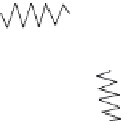Environmental Engineering Reference
In-Depth Information
To obtain total power:
P
T
=
P
1
+
P
2
+
P
3
= 45 watts + 135 watts + 180 watts = 360 watts
To check our answer, the total power delivered by the source can be calculated:
P
=
E
×
I
= 120 volts × 3 amperes = 360 watts
Thus, the total power is equal to the sum of the individual power dissipations.
Note:
We found that Ohm's law can be used for total values in a series circuit as
well as for individual parts of the circuit. Similarly, the formula for power may be
used for total values:
P
T
=
E
T
×
I
(10.11)
g
eneral
s
eries
C
irCuit
a
nalysis
Now that we have discussed the pieces involved in solving the puzzle that is series
circuit analysis, we can move on to the next step in the process: solving series circuit
analysis in total.
■
Example 10.16
Problem:
Three resistors of 20 ohms, 20 ohms, and 30 ohms are connected across a
battery supply rated at 100-volt terminal voltage. Completely solve the circuit shown
in Figure 10.17.
Note:
To solve the circuit, the total resistance must be found first, then the circuit
current can be calculated. When the current is known, the voltage drops and
power dissipations can be calculated.
Solution:
The total resistance is
R
T
=
R
1
+
R
2
+
R
3
= 20 ohms + 20 ohms + 30 ohms = 70 ohms
F
1
Fuse
R
1
20 ohms
+
E
100 volts
R
2
20 ohms
-
S
1
Switch
R
3
30 ohms
FIGURE 10.17
Solving for various values in a series circuit in Example 10.16.








Search WWH ::

Custom Search